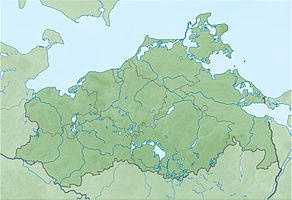Radelsee nature reserve
|
Radelsee nature reserve
|
||
| location | Southeast of Markgrafenheide near the Mecklenburg town of Rostock | |
| surface | 218 ha | |
| Identifier | LU MV 243 (PDF; 217 kB) | |
| WDPA ID | 165081 | |
| Geographical location | 54 ° 11 ' N , 12 ° 10' E | |
|
|
||
| Sea level | from -3 m to -1 m | |
| Setup date | October 23, 1990 | |
| administration | LUNG | |
The Radelsee nature reserve is a nature reserve in Mecklenburg-Western Pomerania . It is located directly southeast of Markgrafenheide and includes the Radelsee and the bogs, meadows and forests connected to the east. The areas were designated as a nature reserve on October 23, 1990 with an extension in 1993. The current size is 220 hectares .
One of the last intact coastal flood bogs in Mecklenburg is to be preserved. Due to the influence of the brackish water , the area is an important habitat for salt-loving animal and plant species. The Radelsee is an important resting area for birds.
The state of the area is rated as good. Positive interventions in the recent past were the desludging of the lake in 1998 and the closure of the sewage treatment plant in the north in 2005.
The lake can be navigated through canals from Markgrafenheide and the Breitling . There is also a hiking trail in the direction of Schnatermann with explanatory boards.
History and water balance
The areas are in the former area of influence of the Warnow , which emerged as an ice age meltwater runoff , which now flows two kilometers further west into the Baltic Sea. Originally the area between the marl cores of the Stoltera and the sand area of the Rostock Heath was open. Coastal compensation processes closed the opening of the Baltic Sea with beach ridges, on which the current locations of Hohe Düne and Markgrafenheide are located. The Warnow adapted its course of the river and at times also emptied into the Baltic Sea in the area of the Radelsee, creating a river delta . After closure of the opening silted and vermoorte the range of up to two meters powerful peat . The Radelsee was closed off by the Breitling.
The peripheral areas of the Rostock Heath were subject to hat use . Part of the area has been used as grassland for centuries. After the grazing was stopped, reeds spread .
Flora and fauna
Extensive salt marshes and brackish water reeds are typical of the protected area. Quarry forests cannot form due to the salinity of the water. Salt-loving plants , rare salt beetles and hoverflies are abundant . In places where the bogs are penetrated by mineral soil, a species-rich mixed forest of oak , holly , wild fruit and juniper grows on old inland dunes .
literature
- Environment Ministry Mecklenburg-Western Pomerania (Hrsg.): Radelsee 243 in: The nature reserves in Mecklenburg-Western Pomerania . Demmler-Verlag, Schwerin 2003, p. 84 f.
Web links
Individual evidence
- ↑ Press release Eurawasser Rostock: Commissioning of the waste water transfer from Markgrafenheide to the Rostock sewage treatment plant ( page no longer available , search in web archives ) Info: The link was automatically marked as defective. Please check the link according to the instructions and then remove this notice.



